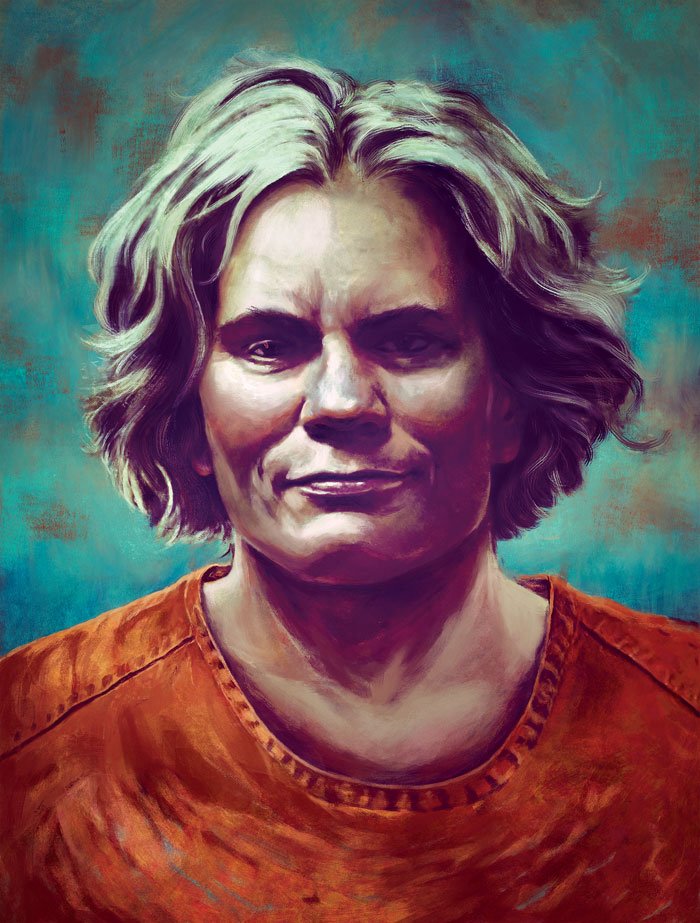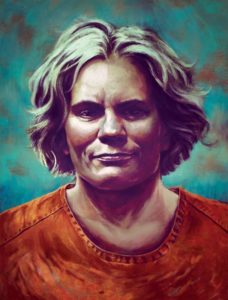

https://www.stlmag.com/longform/pam-hupp/#.WIKFTGk3wdo.facebook
The 911 operator heard a woman refusing to get into a vehicle and begging for help. Gunshots—loud and staccato—cut through the confusion of noises. A smoke alarm shrilled.
When police arrived, a 33-year-old man lay dead inside an O’Fallon, Missouri, house. The caller said the man had climbed into her SUV, held a knife against her throat, and demanded that she take him to a bank to get “Russ’s money.” Terrified for her life, she said, she’d knocked the knife away, run inside through the garage door, dashed into the master bedroom, and grabbed a .38 Ruger revolver from her nightstand. He came after her like “a madman.”
The 911 caller—a 58-year-old woman named Pamela Hupp—was questioned and released.
Seven days later, she was arrested and charged with first-degree murder.
Before being booked, she asked to use the restroom and stabbed herself in the neck and wrists with a ballpoint pen.
St. Louisans squinted at their TV screens, trying to fathom this blond woman, her square jaw set hard, her face impassive. This was the same woman who’d testified three years earlier in a murder trial after her friend was stabbed 55 times. The friend’s husband was convicted and later acquitted. In the meantime, Hupp’s mother had died in a suspicious fall from a third-floor balcony.
The only possible motive connecting all three cases was money. Hupp, who’d held several jobs in the insurance industry, was the beneficiary of both her friend’s and mother’s policies. But would somebody really stab a sick friend and shove her own mother off a balcony to get cash she’d receive in a few years anyway, then shoot a perfect stranger just to twist the plot?
“Even Hollywood,” one St. Louisan tweeted, “doesn’t write scripts this convoluted.”
Pamela Neumann Hupp grew up in an orderly Catholic household in Dellwood, the third of four kids, their mother a schoolteacher, their father a union man who worked for decades at Union Electric. Pam rode bikes with her friends, went Christmas caroling, occasionally skipped Sunday school. At Riverview Gardens High School, she was a blond pompommer with a laugh that burst forth like a geyser, no stopping it.
Pam was always ready for fun, friends recall—no moodiness or drama, no talking behind people’s backs. Her grades could’ve been higher, one friend guesses, “but she was boy-crazy.” By senior year, she’d made a real catch: a boy who was soft-spoken and well-liked, a member of the soccer team, golf team, and National Honor Society. They went to their senior prom together. Three months later they “had to get married.”
Pam’s devout mother couldn’t have been pleased about the pregnancy. Pam did the responsible thing, but her friends sensed a wistful resentment: Everybody else was caught up in the whirl of college, while here she was, sitting in a cheap apartment spooning strained beets.
The marriage lasted six years. Soon after her divorce, Pam married Mark Hupp, a quiet, easygoing guy who played minor-league baseball for the Texas Rangers and, when he didn’t get drafted, fell back on carpentry. They gave Pam’s daughter a little brother, and in 1989 moved to Naples, Florida. When they returned in 2001, they settled in O’Fallon, Missouri, and started flipping houses on the side.
Pam also took a clerical job in a State Farm office, and Betsy Faria was the first person she met there. Eleven years younger than Pam, Betsy was warm-hearted and bubbly and scatterbrained, always short of cash but shored up emotionally by dozens of friends who adored her. Even at 32, she looked like a greeting card illustration—round face, curly hair, pink cheeks, bright-blue eyes—and in her part-time gig as a DJ, she could coax anybody onto the dance floor. Read more >>